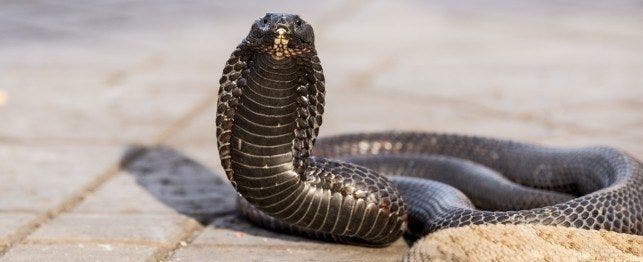
The Egyptian Cobra
According to legend, Cleopatra asked that an asp, an Egyptian cobra, be delivered to her in a basket of figs. The asp was worshipped in ancient Egypt and used as a symbol on the crown of the pharaohs. By allowing this symbol of divine royalty to bite her, Cleopatra was believed to become immortal.
You may be more familiar with the Egyptian cobra as a dancing snake rising up out of the snake charmer’s basket ready to strike, but instead appearing to sway to the music of the flute. In reality, the Egyptian cobra is extremely dangerous and responsible for many human deaths. Contrary to folklore, cobras will seldom attack unprovoked. When threatened, however, the snake will make full use of its deadly force, by attacking and continuing to attack until it feels an escape is possible.
The venom of the Egyptian cobra is neurotoxic, that is it destroys nerve tissue, and it is much stronger than that of the common cobra. This venom has been used for many years in medical research because it has an enzyme, lecithinase, that dissolves cell walls and membranes surrounding viruses. When injected into its prey, the venom causes paralysis and death due to respiratory failure, usually within 15 minutes. With effective serum more available, however, the high death rate in some areas of Asia has decreased.
The Egyptian cobra can grow to eight feet (2.4 meters) long, although the average length is five to six feet. The head is small and flat with a rounded snout. The body is moderately stout, tapering gradually to a pointed tail. The scales are smooth, large and distinct and colors vary from grayish yellow to brown to almost black.
When threatened, the snake raises the front part of its body and spreads its neck into a hood. Dark bars are displayed on the throat and front of the hood, but the back is unmarked. The cobra is almost always portrayed in this most distinctive pose.
The Egyptian cobra is a fast-moving snake and is thought to be very intelligent and relatively docile. A nighttime hunter, it forages mainly for toads, lizards and birds in habitats that include savannahs, woodlands, grasslands and semi-desert areas of Northern Africa. Individual snakes often feign death if their threat posture fails to intimidate a predator, but this behavior is rare.